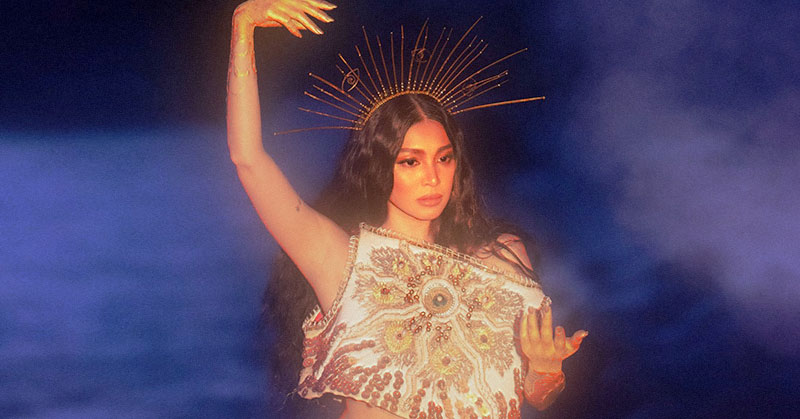The beauty of Wildest Dreams lies not in its big gestures, but its subtleties
You could say that Nadine Lustre has been reborn many times. Time travel back to her 2014 self-titled EP and it doesn’t sound like the same person, cookie cutter artista pop unmoored by a guiding creative vision. The formation of Careless Music signalled a new beginning for the artist, but had yet to give Lustre her defining moment. Singles like St4y Up, I Like It from the collective’s 2018 mixtape, and No 32 with Ruby Ibarra saw Lustre polishing her chops, but these songs were otherwise pretty forgettable, and she was still getting her sea legs.
And then she released Wildest Dreams, an ambitious visual album in which Lustre, invoking the heady symbolisms of Philippine mythology, while guided by Campbellian sages, embarks on a journey of self-love and total transformation. This affinity for the natural world and a thematic focus on healing is comparable to NIKI’s MOONCHILD EXPERIENCE, or the stuff June Marieezy is doing as (((O))). It’s a trip, but for all its production, the visual album uses roughly half of the record, and therefore tells only half the story. Assess it as a strictly musical product, and the vision of Wildest Dreams becomes more distinct, its energies more vivid.
RELATED: The Masochistic Tendency of Pop in Conan Gray’s ‘Heather’
With this record, Lustre bifurcates her history, and the musician she used to be becomes a shadow of the artist she is working to become. We are compelled to look at her artistic history as pre- and post-Wildest Dreams. Right from the intro track, she tells us to Dance with Danger, and go with her on a journey imperilled by newness, vulnerability, and risk.
When Lustre tries to do something new, it pays off greatly. Intoxicated is a real swinger with a UK Garage flavor, its skittish beats complementing Lustre’s sense of prosody, giving this song basically about getting turned up a lot of sonic depth. Glow is another highlight in this album, which opens up with a sequence of kulintang-like tolls before passages move into each other seamlessly, an unimpeded flow of energies. Perhaps Lustre’s greatest strength as a singer is her sense of rhythm, as evidenced by Seconds, a love song with an uncanny retro R&B vibe, almost TLC-esque, and Grey Skies, where Lustre’s vocals maneuver artfully through a house-y beat. There’s a surprising amount of range on this album, and through songs like these, Lustre’s claim of rebirth is substantiated.
The short film that accompanies the album is full of big, sweeping symbolic gestures, but I believe the key to appreciating Wildest Dreams as a whole lies in recognizing its subtleties. The production and mixing by Marcus Davis is on point, all elements held in balance. Save a Place is a moving ode to Lustre’s brother Isaiah, who died to suicide in 2019, and what lifts it to divine heights are Lustre’s vocal delivery, fittingly angelic as if having arrived at a sense of peace, and harp-like strings doing butterfly wingbeats in the back of the mix. The couplet “But a river full of tears couldn't wash the pain out, no no / Learned to put my walls up to keep the rain out” is, ironically, powerful enough to bring walls down. What follows is You Can Stay, surprisingly full-bodied for a song that functions more like an interlude, with Lustre’s vocal harmonies mingling with effervescent textures.
Wildest Dreams, and its accompanying short film, try to be sublime. But these efforts are marred by some of the album’s productions and arrangements keeping to Careless’s sonic comfort zone—a penchant for cookie cutter drill beats and trap beats, and woozy textures ala The Weeknd during his House of Balloons phase. Songs like Dance With Danger, Natural, and even the album’s title track expose this weakness. Wildest Dreams as a whole reminds me a lot of Ariana Grande’s work Sweetener onwards, which eschews anthemic birit tropes for more easygoing, downtempo grooves—a sensible move for, let’s be honest, an artist whose vocal ability is average at best. That’s not a bad thing, but a style like that makes it easy for tracks to bleed into each other in a way that blends into wallpaper. It probably speaks to Lustre’s ability as a musician, though, that the weakest tracks on the record are the ones with the features—Massiah and James Reid’s flows are alright, but I think Complicated Love and White Rabbit would be better with just Nadine.
RELATED: An Exclusive with Griff: The Next Face of British Pop
The album is a rewarding listen to the attentive, but I don’t believe that Nadine Lustre is at the final stage of her transformation. That’s a good thing—we get to see Lustre in the middle of her becoming. Perhaps down the line, we might be able to see her and the rest of Careless take greater creative risks, and truly unshackle themselves from the easy conventions of Manila R&B. And while I remain blasé about Careless’s plans for national domination, Wildest Dreams shows promise. The artist has already given herself permission to feel, to trust her vision, to be one with others, and to dream wildly. The next step is to dream a little wilder.
Words Jam Pascual
Art Matthew Ian Fetalver


















